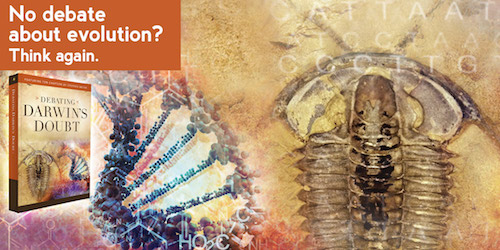 Evolution
Evolution
 Intelligent Design
Intelligent Design
Biochemist Larry Moran Denies Darwin’s Doubt, and We Doubt His Arguments

It has come to my attention that Larry Moran, professor of biochemistry at the University of Toronto, feels left out of the debate about Darwin’s Doubt, documented in Debating Darwin’s Doubt. He writes in a post on his blog that he’s “a little miffed” about being omitted from the latter. Moran posted a number of critiques of Stephen Meyer’s book, to which we offered no response at the time. No slight intended, Dr. Moran.
I have now taken a look at the first two of his posts, and noticed some biases. Moran showed a few illustrations that might impress the uninformed, but it’s what he didn’t say that is revealing.
Trees seeking to represent the history of life are drawn to convey different meanings. Moran’s tree shows the diversity of life from a phylogenetic view. Of course, unicellular organisms represent the vast majority of this tree, leaving plants, animals, and fungi to one tiny portion of the tree, indicated by a circle. Moran implies that this indicates the Cambrian explosion was a mere blip. What he doesn’t say is that the Cambrian explosion resulted in the sudden diversity of metazoa, or multicellular organisms like animals and seaweed, for which we have many fossils. As a portion of the diversity on the planet they may be a small fraction, but that doesn’t mean the explosion wasn’t real.
Take a look at Figure 1 from a paper on the subject (“The Cambrian ‘explosion’: Slow-fuse or megatonnage?“) by Simon Conway Morris, an expert in the field. The first fossils for each group are indicated by solid circles. The branch points and putative common ancestors are indicated by asterisks, but have not been observed in the fossil record. To the left are the dates in millions of years. You can read across the tree and see that most of the phyla appear between about 525 and 535 million years ago. That is sudden in geologic time. The few groups present in the Vendian (pre-Cambrian) and still with us today include the fungi, the sponges, and sea anemones. All the rest of the phyla except one, which appears later, first come on the scene in the Cambrian. That is a short time for such basic differences in body plans to appear.
Morris ends his paper with this:
To conclude: The Cambrian explosion is real and its consequences set in motion a sea-change in evolutionary history. Although the pattern of evolution is clearer, the underlying processes still remain surprisingly elusive.
Moran’s figure (where apparently a number of phyla have been demoted to classes) reveals the same problem. If you take into account where the circles (the crown groups) are, you will see that the major groups of animals first appear as fossils in the same narrow window. The rest of the branch points are phylogenetic inferences from molecular data, for which no fossils exist.
How did such diverse animals first appear? And how do we reconcile morphological data from fossils (and studies of modern representatives) with the molecular data that keeps pouring in? It is not so easy. A recent paper by Ronald Jenner (“Macroevolution of Animal Body Plans: Is There Science after the Tree?“) acknowledges the problem. His abstract:
A renewed emphasis on the gaps in organization that exist between the crown-group body plans of higher-level animal taxa is a hallmark of the emerging consensus in metazoan phylogenetics. Bridging these gaps is the greatest hurdle that stands in the way of translating our knowledge of phylogeny into a renewed understanding of the macroevolution of animal body plans. Unless a good fossil record is available, there is little hope that we will be able to bridge many of these gaps empirically. We have, therefore, little choice but to resort to our more-or-less informed imagination to produce the historical narratives that are the ultimate goal of our studies of animal evolution. Only by fully engaging with the challenges of devising testable scenarios will we be able to tell where along the spectrum of science and fiction our understanding of animal body plan evolution will finally come to rest. [Emphasis added.]
Strong language. There’s more in the paper:
The phylogenetic lineages of the major metazoan crown groups are discouragingly short in terms of the number of nodes available along each lineage for resolving the assembly of body plans. This seriously limits the resolution achievable by scenarios, especially in the absence of fossils, but before any evolutionary transformations between body plans can be traced, we must infer hypothetical ancestors. In their recent book on the Cambrian explosion, Erwin and Valentine (2013) likened our attempts to infer the body plans of ancient animal ancestors to s�ances. The older the nodes in question, the more apt this analogy is. The divergences between most pairs of higher-level crown-group-sister taxa are so significant that the inferences of hypothetical ancestral body plans are generally accompanied by substantial error bars. These become compounded as one integrates the inferences of increasing numbers of hypothetical ancestors to reach deeper and older nodes in the tree. Add to this matrix of uncertainty the potentially limitless play of our imagination, and our attempted explanatory historical narratives may end up being little more than untestable fiction.
Since these were some of the main points of Darwin’s Doubt, perhaps it’s fair to say there is reason to doubt that scientists have it all worked out. Sorry, Dr. Moran.
